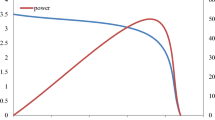Abstract
The presented paper deals with the analysis of a two-stage constant power generation (CPG) interfaced with a grid-tied solar photovoltaic power system (GTSPPS). In earlier days, for extracting the maximum power point in GTSPPS, different types of MPPT controllers were used. These techniques fail whenever a change in solar irradiance takes place. A CPG technique was proposed that makes use of a single stage, but this technique still has a drawback as its operating area always lies to the right of MPPT, so whenever a sudden change in solar irradiance occurs, the robustness of the CPG algorithm decreases. Thus, there is a need for two-stage CPG so as to have a stable, constant power generation. Further, the performance of two-stage CPG has been compared with different control techniques under dynamic as well as steady-state conditions to know its suitability under practical conditions.

































Similar content being viewed by others
References
Stetz T, Marten F, Braun M (2013) Improved low voltage grid-integration of photovoltaic systems in Germany. IEEE Trans Sustain Energy 4(2):534–542
Ahmed A, Ran L, Moon S, Park J-H (2013) A fast PV power tracking control algorithm with reduced power mode. IEEE Trans Energy Convers 28(3):565–575
Yang Y, Wang H, Blaabjerg F, Kerekes T (2014) A hybrid power control concept for PV inverters with reduced thermal loading. IEEE Trans Power Electron 29(12):6271–6275
Yadav U, Gupta A, Ahuja R (2020) Robust control design procedure and simulation of PRES controller having phase-locked loop (PLL) control technique in Grid-Tied Converter. In: 2020 3rd international seminar on research of information technology and intelligent systems (ISRITI), pp 445–450. https://doi.org/10.1109/ISRITI51436.2020.9315358
Esram T, Chapman P (2007) Comparison of photovoltaic array maximum power point tracking techniques. IEEE Trans Energy Convers 22(2):439–449
Hohm D, Ropp M (2000) Comparative study of maximum power point tracking algorithms using an experimental, programmable, maximum power point tracking test bed. In: Presented at IEEE 28th photovoltaic specialists Conference, Anchorage, AL, USA
Hanzaei SH, Gorji SA, Ektesabi M (2020) A scheme-based review of MPPT techniques with respect to input variables including solar irradiance and PV arrays’ temperature. IEEE Access 8:182229–182239. https://doi.org/10.1109/ACCESS.2020.3028580
Yap KY, Sarimuthu CR, Lim JM-Y (2020) Artificial intelligence based MPPT techniques for solar power system: a review. J Mod Power Syst Clean Energy 8(6):1043–1059. https://doi.org/10.35833/MPCE.2020.000159
Tousi SMR, Moradi MH, Basir NS, Nemati M (2016) A functionbased maximum power point tracking method for photovoltaic systems. IEEE Trans Power Electron 31(3):2120–2128
Teng JH, Huang WH, Hsu TA, Wang CY (2016) Novel and fast maximum power point tracking for photovoltaic generation. IEEE Trans Ind Electron 1:1
Ghasemi MA, Forushani HM, Parniani M (2016) Partial shading detection and smooth maximum power point tracking of PV arrays under PSC. IEEE Trans Power Electron 31(9):6281–6292
Yuwanda RI, Prasetyono E, Eviningsih RP (2020) Constant power generation using modified MPPT P&O to overcome overvoltage on solar power plants. Int Semin Intell Technol Appl (ISITIA) 2020:392–397. https://doi.org/10.1109/ISITIA49792.2020.9163685
Femia N, Petrone G, Spagnuolo G, Vitelli M (2009) A technique for improving P&O MPPT performances of double-stage grid-connected photovoltaic systems. IEEE Trans Ind Electron 56(11):4473–4482
Koutroulis E, Voulgaris N (2001) Development of a microcontroller-based, photovoltaic maximum power point tracking control system. IEEE Trans Power Electron 16(1):46–54
Chiu H, Lo Y, Yao C, Lee T, Wang J, Lee J (2011) A modular selfcontrolled photovoltaic charger with interintegrated circuit (I2 C) interface. IEEE Trans Energy Convers 26(1):281–289
German federal law: renewable energy sources act (Gesetz fur den Vorrang Erneuerbarer Energien), BGBl Std, Document No: BGBl. I S. 1066, Jul 2014Mar
Energinet.dk, “Technical regulation 3.2.5 for wind power plants with a power output greater than 11 kW,” Energinet.dk, Errits, Denmark, Document No: 55986/10, Tech Rep, 2010
Tafti HD, Maswood AI, Konstantinou G, Pou J, Blaabjerg F (2018) A general constant power generation algorithm for photovoltaic systems. IEEE Trans Power Electron 33(5):4088–4101. https://doi.org/10.1109/TPEL.2017.2724544
Yang Y, Blaabjerg F, Wang H (2014) Constant power generation of photovoltaic systems considering the distributed grid capacity. In: 2014 IEEE applied power electronics conference and exposition-APEC 2014, pp. 379–385. https://doi.org/10.1109/APEC.2014.6803336
Wandhare RG, Agarwal V (2014) Precise active and reactive power control of the PV-DGS integrated with weak grid to increase PV penetration. In: Proceedings photovoltaic specialist conference, pp. 3150–3155
Cao W et al (2013) Two-stage PV inverter system emulator in converter based power grid emulation system. In: 2013 IEEE energy conversion congress and exposition, pp 4518–4525. https://doi.org/10.1109/ECCE.2013.6647305
Urtasun A, Sanchis P, Marroyo L (2013) Limiting the power generated by a photovoltaic system. In: Proceedings systems & signals devices, pp. 1–6
Blaabjerg F, Teodorescu R, Liserre M, Timbus AV (2006) Overview of control and grid synchronization for distributed power generation systems. IEEE Trans Ind Electron 53(5):1398–1409
Yang B, Li W, Zhao Y, He X (2010) Design and analysis of a gridconnected photovoltaic power system. IEEE Trans Power Electron 25(4):992–1000
Yang Y, Blaabjerg F, Wang H (2014) Constant power generation of photovoltaic systems considering the distributed grid capacity. In: Proceedings applied power electronics conference, pp. 379–385
Messai A, Mellit A, Guessoum A, Kalogirou SA (2011) Maximum power point tracking using a GA optimized fuzzy logic controller and its FPGA implementation. Sol Energy 85:265–277
Sangwongwanich A, Yang Y, Blaabjerg F (2016) High performance constant power generation in grid connected PV systems. IEEE Trans Power Electron 31(3):1822–1825
Acknowledgements
The work written is entirely original, acknowledges all sources of data and appropriately represents the work or words of others in citations or quotations.
Author information
Authors and Affiliations
Corresponding author
Additional information
Publisher's Note
Springer Nature remains neutral with regard to jurisdictional claims in published maps and institutional affiliations.
Rights and permissions
About this article
Cite this article
Yadav, U., Gupta, A. & Ahuja, R. Analysis of High-Performance Two-Stage CPG Interfaced with GTSPPS. Electr Eng 106, 1825–1839 (2024). https://doi.org/10.1007/s00202-022-01611-7
Received:
Accepted:
Published:
Issue Date:
DOI: https://doi.org/10.1007/s00202-022-01611-7




